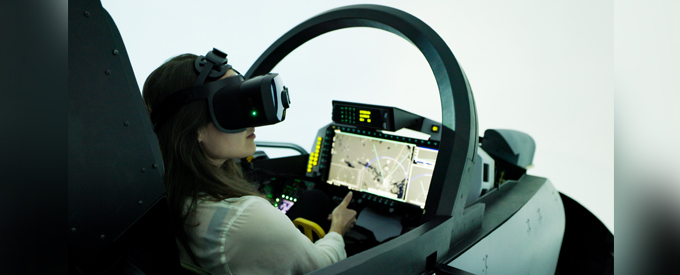2021-07-05
Saab and Varjo Join Forces to Bring VR to Flight Simulators
Saab and the Finnish company Varjo Technologies have teamed up to revolutionise flight simulators. Varjo has developed a human eye resolution mixed reality (XR) technology that will reportedly be integrated into all Saab Gripen E/F simulators. This integration will allegedly offer the highest resolution and widest field of view in the industry, along with numerous new training opportunities.
Varjo Technologies develops virtual and mixed reality technologies for professional use and was founded in 2016. The company has been collaborating with Saab for many years. The collaboration has its roots in Varjo’s innovation, which was critical to the successful development of state-of-the-art simulations.
“When we did our first experiments with commercial devices, we received feedback from the pilots that they were unable to read text in virtual reality because the resolution was not sufficiently high. This was not a problem with Varjo’s technology,” says Stefan Furenbäck, Saab’s Head of Tactical Environment Simulation and Visualisation.
“Our collaboration has been smooth and straightforward. We understand each other’s needs and how we can solve our shared technological problems. Two companies with similar cultures, with innovation high on their agenda and ready to discuss everything,” adds Seppo Aaltonen, Varjo’s Chief Commercial Officer.
Perfect Clarity
Pilot training requires trainees to be able to read text and see even the smallest details. Pilots need to feel like they are flying in the real world while using the simulator. Up until now it has been necessary to use cave or dome-shaped simulators to create a virtual reality experience that is as immersive as possible for the pilot. They are very large and expensive, and building their display systems requires a lot of work. They are also difficult to move.
Conventional dome simulators have a flat screen, and the 3D view can only be achieved using special glasses. Varjo’s virtual headsets have separate screens for each eye, so they come with a built-in 3D feature. Moreover, its Bionic Display is based on the idea of how human eye works; you see everything in the middle of your field of vision in ultra-high resolution and anything in the peripheral vision in lower resolution, enabling a fully natural and smoothly performing virtual experience. This is done by projecting patterns on the surface of the eye with infrared LEDs that are monitored by small cameras and the resolution adapts to the movements of the eye. Human-eye-level resolution can be achieved without supercomputers if it is known what point the human eye is looking at, at any given moment. The maximum computing power is always focused on the current point.
Varjo’s technology uses video cameras to constantly capture the environment for the purposes of mixed reality. This means that the images from the real-world work on the same principle – the high-resolution image comes from the focal point. This allows powerful gaming computers to be used to operate the technology instead of supercomputers.
“We’re finalising the basic functionalities in our own simulator so that we can use Varjo’s XR-3 headsets in all our flight simulators. We’ve previously carried out smaller, independent prototype-like projects but now we’re integrating them into our actual flight simulators,” highlights Furenbäck.
Varjo headsets provide the highest resolution (over 70 ppd) ever experienced in a simulation and training environment. With the Bionic Display, users can read displays, controls, text, symbols and distant objects in perfect clarity. When training with Varjo devices, users will see the critical details near and far. Varjo XR-3 video pass-through RGB cameras and LiDAR sensor enable accurate room, object, body and hand occlusion with real-world objects in real time.
The XR-3 mixes real and virtual content with support for tactile feedback to deepen the immersion. Users can fully interact with a physical panel, HOTAS or crew member to replicate real training scenarios with true-to-life accuracy.
Moreover, Varjo’s mixed and virtual reality headsets are fully compatible with a rapidly expanding collection of the most widely used 3D platforms and software.
Its headsets are ergonomically designed to be lightweight with a 3-point precision fit head band for maximum comfort – perfectly fitting any head shape and size. Combined with ultra-wide, Non-Fresnel lenses, automatic interpupillary distance (IPD) adjustment, and active cooling, they enable a comfortable experience even for extended XR/VR sessions without any simulator sickness. Users can also use any preferred headphones with microphones.


No Comments